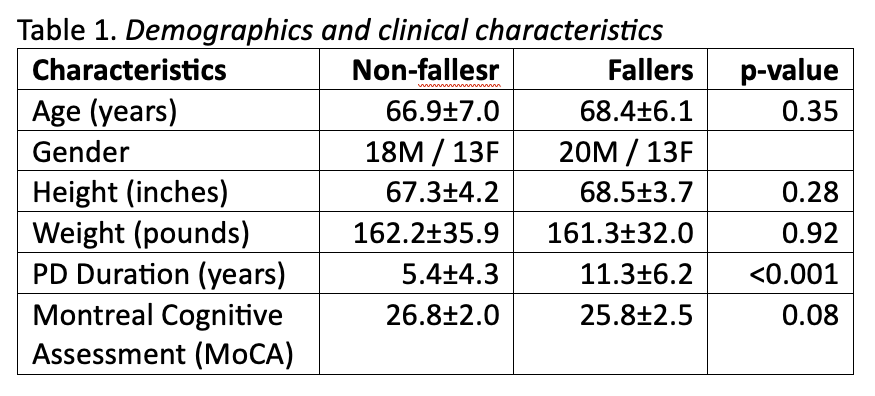Objective: To determine if a comprehensive balance assessment on a posturography system can identify retrospective Fallers from Non-fallers in people with Parkinson’s disease (PwPD). We are also exploring the relationship of a fall risk index to future falls in the same group of people.
Background: Falls in PwPD often result in injuries and loss of independence. Thus, it is important to accurately determine who is at risk of a fall in the near future, so that an appropriate intervention can occur to mitigate the risk. We hypothesized that a posturography system, with assessment of several domains of balance, to calculate a fall risk index for older adults [1] would also be effective for PwPD.
Method: 64 PwPD were tested in the On-medication state (MDS-UPDRS, part III = 35.4±10.7). The fall risk score (Silver Index) was calculated based on performance of static and dynamic balance, sensory integration, reactive balance, sit-to-stand, limits of stability, and gait speed, as well as previous falls and age; scores range from 0-100%, with higher scores indicating a higher fall risk. Prospective falls are tracked for 12 months. Groups were based on retrospective falls in the past year: Non-faller = 0 falls; Faller ≥ 1 fall. See Table 1 for group characteristics.
Results: The Silver Index was significantly higher in the Faller group than the Non-faller group (56.05±25.58%, and 27.74±19.39%, resp.), indicating a higher risk of future falls (p<0.001). Among the sub-scores, dynamic balance (p<0.037) and limits of stability (p<0.034) were significantly different. Thus far, 29 participants have completed prospective falls tracking. In the Non-faller group 7 experienced a fall while 8 in the Non-faller group continued without any falls (Silver Index scores were 33.0±21.5 and 13.2±8.3, resp.). Correlation analysis showed the Silver Index was significantly correlated with MDS-UPDRS, part III (r=0.55, p<0.001), PIGD sub-score (0.61, p<0.001), and the number of prospective falls (r=-0.50, p<0.007).
Conclusion: Our results suggest that the Silver Index may be useful in PwPD. Limits of stability and ability to maintain dynamic balance on a moving surface appear particularly important for fall risk in Pw PD. Prospective falls tracking is ongoing and preliminary results indicate a good relationship between the fall risk index and future falls.
Table 1
References: [1] Cella A, De Luca A., Squeri V., Parodi S., Vallone F., Giorgeschi A., Senesi B., Zigoura E., Guerrero K., De Michieli L., Saglia J.A., Sanfilippo C., Pilotto A. (2020) Development and validation of a robotic multifactorial fall-risk predictive model: a one-year prospective study in community-dwelling older adults, PLoS ONE 15(6): e0234904. https://doi.org/10.1371/journal. pone.0234904.
To cite this abstract in AMA style:
P. Carlson-Kuhta, C. Silva-Batista, A. Ragothaman, M. Abdollahi, J. Ellison, G. Harker, G. Marchesi, A. de Luca, V. Squeri, F. Horak, M. Mancini. Evaluating Fall Risk in People with Parkinson’s Disease Using a Novel Comprehensive Posturography Assessment [abstract]. Mov Disord. 2024; 39 (suppl 1). https://www.mdsabstracts.org/abstract/evaluating-fall-risk-in-people-with-parkinsons-disease-using-a-novel-comprehensive-posturography-assessment/. Accessed December 28, 2025.« Back to 2024 International Congress
MDS Abstracts - https://www.mdsabstracts.org/abstract/evaluating-fall-risk-in-people-with-parkinsons-disease-using-a-novel-comprehensive-posturography-assessment/

